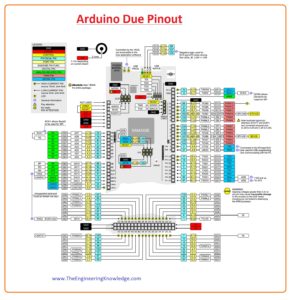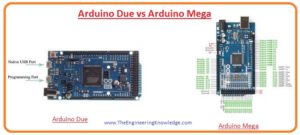 Hello respected student I hope you all are doing great. In today’s post, we will have a detailed look at Introduction to Arduino Due. It is a microcontroller based on the Atmel SAM3X8E ARm Cortex-M3 central processing unit. This first Arduino created on the thirty two-bit ARM core microcontroller is Arduino Due. In this module there are fifty-four pinouts assembled through which twelve can be used as pulse width modulation outputs pints, twelve pinouts are used as analog inputs four pinouts used as UART.
Hello respected student I hope you all are doing great. In today’s post, we will have a detailed look at Introduction to Arduino Due. It is a microcontroller based on the Atmel SAM3X8E ARm Cortex-M3 central processing unit. This first Arduino created on the thirty two-bit ARM core microcontroller is Arduino Due. In this module there are fifty-four pinouts assembled through which twelve can be used as pulse width modulation outputs pints, twelve pinouts are used as analog inputs four pinouts used as UART.
Over this board, every parameter required to operate the controller is assembled for use of these features just attach it with the computer through a micro USB for the power supply or you can deliver power through the use of ACtoDC converter. This module is operatable with all types of Arduino categories that operate on the 3.3 volts and it can be interfaced with the pinout of Arduino 1.0. In today’s post, we will have a detailed look at its working, applications, pinouts, and some other related parameters. So let’s get started with
Introduction to Arduino Due
- The first type of Arduino created which follows the thirty-two bit ARM structure is Arduino Due. Normally another Ardunio board is based on the structure of Atmega 328.
- In this category of Arduino Atmel SAM3X8E ARM Cortex-M3 microcontroller exits. This module consists of fifty-four pinouts.
- Out of these fifty-four pinouts, twelve operates as pulse width modulation outputs twelve as analog inputs four are UARTs and clock given to this board has a frequency of eighty-four megahertz.
- In this board USB OTG can be connected, two analogs to digital converter can be connected with this module. Two TWi, power jack SPI header erase button and lot of other function which makes your task easy available in this module.
- There are some other features it provides like DAC, acoustic, DMA, multiple tasking performing library and some other.
- To provide protection from electric shock this module covered with the plastic sheet that makes it secure for users.
- For writing the code of project which you are performing at the ARM processor you must required currently used model of Arduino IDE:1.5.
- In this board, JTAG is assembled to make sure of the connection between the pinouts of the board.
- Other types of Arduino’s used five voltage for their operation but this model operates on the 3.3 volts. A larger value of voltage can be dangerous for the board and affect its performance.
Features of Arduino Due
- These are some pinouts of Arduino due which are described here with the details.
- The SAM3X8E thirty-two bit ARM microcontroller is used in this Arduino.
- This module operates on 3.3 volts.
- The value of extreme current given at the input and output pinouts of these modules is three-ampere milliamperes and fifteen milliamperes.
- The net current drawn from all pinouts is one thirty milliamperes.
- The flash memory of 512KiloBytes exits on this board.
- Sixteen kilobytes EEPROM exits on this board.
- It has ninety-six bytes inner random access memory.
- The inner clock has twelve megahertz frequency and the exterior clock has eighty-four megahertz frequency.
- The temperature over which it works is -40ºC to +85 centigrade.
- The creator of this module is Arduino.cc.
- Arduino Software (IDE) is used for the operation of this board.
- This board has one reset button and one erasable button.
Arduino Due Pinout
- There are fifty-four pinouts are designed on this board which is discussed here with the details.
| +5V, +3.3V, GND and Vin | Plus five volts are given at the terminal of +5V pin, plus 3.3 volts are provided at pinout of +3.3V at Vin plus seven volts to plus twelve volts are provided. GND is connected with the ground. |
| UART, SPI, TWI CAN, SSC |
|
| I/O PINS | There are fifty pinouts exits in the boards forty-two are inputs and outputs and 12 are pulse width modulation. |
| ADC0, to ADC11 | These pins are used to provided analog signals as input to the board and provides twelve bit of resolution. |
| DAC0, DAC1 | Two get analog output from the board these two channels are used. |
| PIN2 to PIN13 | This series of pinouts is used to get pulse width modulation output from the board. |
| RESET | It used to reset the MCU. |
| EXTERNAL INTERRUPTS | All pinouts which are either input or output can be used as interrupts. |
| TEMPERATURE SENSOR | With the channel ADC15, inner configured temperatures are connected on this board. |
Where we can use ARDUINO DUE
- The Arduino board is very commonly used in different types of engineering and embedded projects but Arduino Due is very less used since its controller is ARM and operating voltage is 3.3 volts while other Arduino modules operate on five volts so it does not compatible with some sensors.
- It is preferred for complicated projects such as CN or three-dimensional printer.
- As it is an open-source module so we can get every kind of data through this module and customize it when required.
- Before using this module there is some factors you must keep in mind are explained here.
Factor One
- In such system where large processing is required Arduino UNO and NANO perform limited operation due to their clock speed of sixteen megahertz. While DUe has a five-time larger clock speed of eighty-four megahertz and can perform a function that is not done by the other boards.
Factor two
- If you are working in such project where you have to connect numerous device in a single unit than Arduino due is preferred since it has fifty-four pinouts
Factor three
- For such an application where the analog output is needed Arduino Due is preferred over other types of Arduino.
Factor Four
- Due to numerous pulse width and analog to digital converter pinouts, Arduino due is preferred over other categories of Arduino.
Factor Five
- In such an application where high electromagnetic interference exits due Arduino is preferred due to its CAN interfacing which can handle such types of applications.
Arduino Due vs Arduino Mega
Applications of Arduino Due
- These are some applications of Arduino Due.
- It used in different types of electronic and embedded projects.
- It used in power supply network.
- It uses in IoT projects.
- In industries for controlling different devices.
That is all about Arduino Due if you have any further query ask in comments. Thanks for reading. have a good day,










